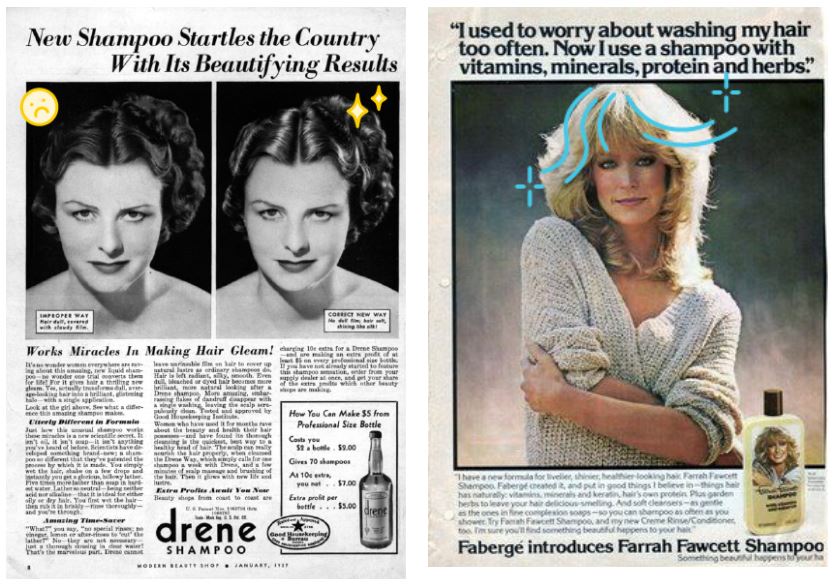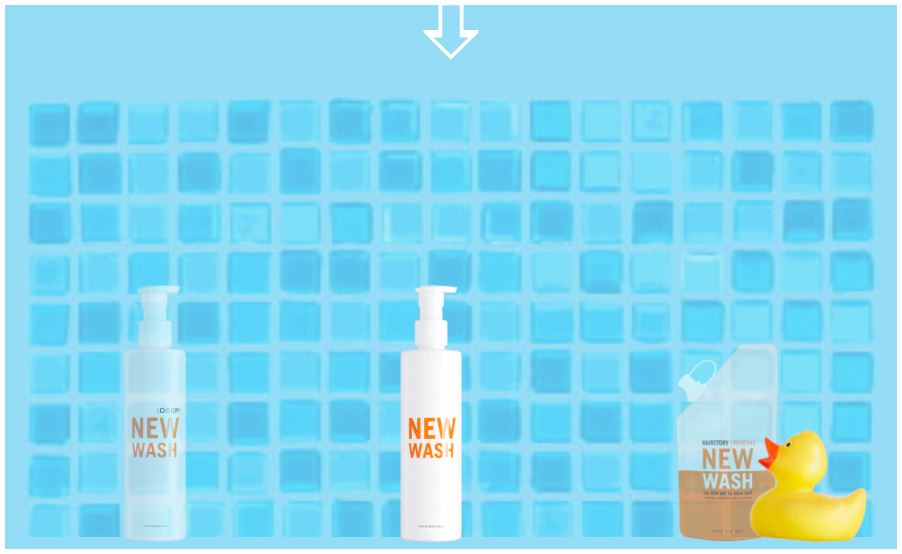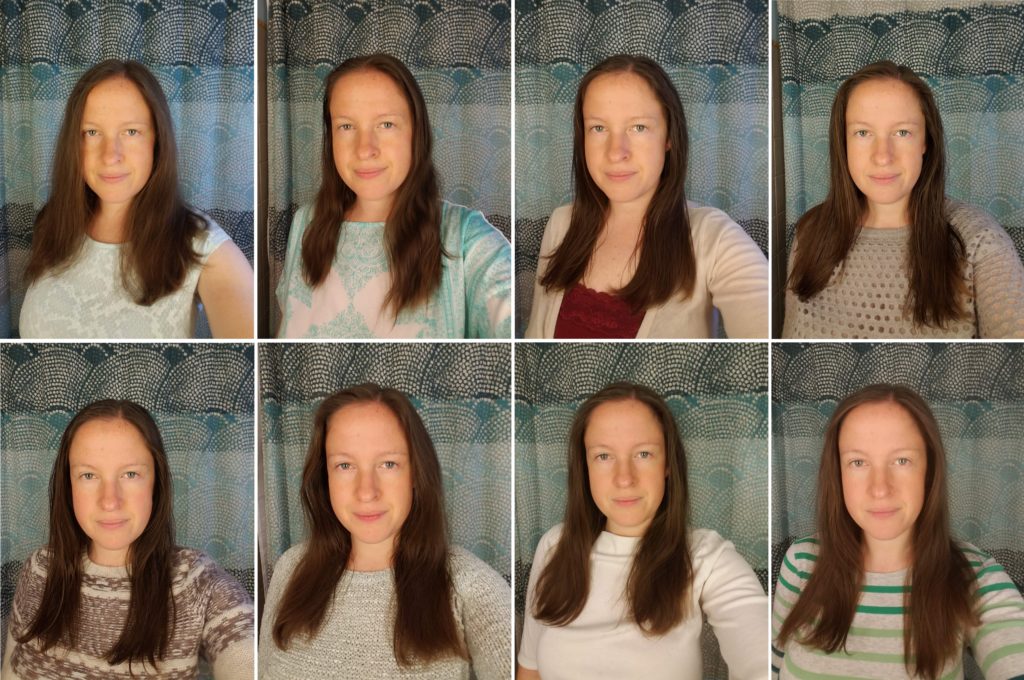A few years ago, a friend told me she was trying the “no-poo” challenge, which I quickly (and gladly) found out referred to shampoo. The idea behind this movement is that shampoo strips your hair and scalp of natural oils that keep it healthy, so going for longer periods of time without using shampoo is better for you. The challenge that friends and coworkers of mine undertook was using no shampoo for 30 days.
Shampoo seemed to me at the time to be quite the random target for this trending elimination challenge, with its photos and hashtags, and which I thought may have been fueled largely by pseudo-science and no small bit of marketing for alternative hair products. However, if it meant less time I had to spend getting ready in the morning, I figured it was worth taking a look into it and trying it out myself.

Development of hair products in the 20th Century
It wasn’t that long ago that we as Americans did not wash our hair every day. In fact, you likely have family members who at one point didn’t even wash their hair at home. Just after the turn of last century, commercial shampoos and other hair products started to become commercially available. In 1908 (the year my grandmother was born), the New York Times published instructions on how to use shampoo, saying that it should be used “about once a fortnight.”[2]
At this point, shampoos were still mostly glorified soap, leaving hair dull after rinsing. However, as the 20th century moved along, formulas advanced to include synthetic surfactants and detergents to clean the hair more thoroughly (1930s and ‘40s), as well as adding polymers to produce a more attractive effect (1960s). And along with these shifts in chemical components, promotion of the product changed as well. In the 1950s, many women in the US would go to a salon to have their hair shampooed and styled once a week. By the 1970s, hair icon Farrah Fawcett was appearing in advertisements saying that you can shampoo your hair “as often as you shower.”[3]
By the 1980s, many formulations began to include silicone, which, like polymers, fills in ruts and makes hair shiny. These are used in shampoo to create a thin layer around each hair, which makes the surface smooth and reduces friction between individual strands.[4] While this may seem like a good thing at first, layers can build up over time, weighing hair down and drying it out. Because of this silicone buildup, natural oils from your scalp cannot penetrate into the hair itself and create a greasy appearance as they sit on top of the silicone barrier. As users desire to eliminate this buildup, they may use shampoos that contain harsh detergents, which strip away not only the silicone buildup but the natural oils from the scalp as well, irritating skin and continuing to dry out hair.[5]

My Challenge
The “No-Poo” Challenge gained momentum in 2007 after an Australian radio host challenged his listeners to go without shampoo for six weeks. The rationale is that shampoos strip away the sebum oil produced by the scalp, and the more often you shampoo, the more sebum your scalp produces to compensate, resulting in greasy hair and an unhealthy scalp.[7] By interrupting the cycle of shampoo use, your hair and scalp can return to their natural state. People with naturally oily hair can use baking soda or vinegar instead of shampoo for a deeper clean, but many can just rinse with water.[8]
It was about four years ago when both a friend from school and a co-worker were trying out this challenge and touted its benefits to me. At that point, daily shampooing and styling were a necessity for me with my short hair – it wasn’t long enough to simply brush back into a ponytail, which can hide a lot of flaws. My hair is very fine, and although I was shampooing every morning with organic shampoos that contained no synthetic ingredients, my hair still looked limp and greasy by evening. I wasn’t convinced I’d be able to succeed at this challenge.
Instead of going all-in with a 30-60 day challenge, I started off by trying to shampoo my hair every other day. At first it was terrible. I spent off-days with my hair looking so greasy I was embarrassed to leave the house. After a long time (probably several months), my off-days started to look alright. At that point, I extended my shampooing to every third day, and once my scalp adjusted, every fourth day, and so on. I regret not keeping track of how long this process took, but I believe it was last year when I was finally down to once a week.
This past summer, however, after a string of camping trips, I decided to see how long I could go with just rinsing my hair, instead of shampooing. As of this post, I’ve shampooed my hair about three times in the last six months, and, while it doesn’t look as good as it does right after a shampoo, it’s much closer than I expected. I have noticed that my hair actually goes through phases over time: after the initial cleanliness diminishes, it looks a little greasier for a while, but then it starts to return to that initial post-shampoo appearance – almost. After rinsing with water and blow-drying it seems that my hair has slightly less volume, it looks slightly stringier, and seems slightly stiffer, but it actually feels thicker in my hands.
It also helps that my hair has grown out some over the last year, so it is long enough to put in a ponytail or braid. I have taught myself to do various braids on my own hair this year, and some of them stay put for the better part of a week, meaning I don’t even need to think about my hair in the morning (which I love). It’s also nice to have an arsenal of hairstyles at the ready for more formal events when straight, stringy hair would not be appropriate.

The Verdict
The thing that shocked me the most in doing the research for this post is how many websites came up in an internet search with information about eschewing shampoo, but then turned out to be selling shampoo and hair products. We are consumers by nature in the United States: it is built into our culture, and telling us to use less of something (when so often we buy products to solve problems) is simply counter-intuitive. It is amazing to me to observe the shift in consumer behavior and perceptions in the span of just one century – all due to marketing. And while the human race lived for millennia without shampoo, I know many people who cringe at the thought of using shampoo only once a month. In fact, I got that reaction from some friends when I told them about this blog post.
Ultimately, there does not appear to be a consensus on the benefit of foregoing shampoo.[9] Every body is different: hormones, diet, and genetics all play a huge role in sebum production, and what works for one person may not work for another. You can always check with your hair dresser or dermatologist for specifics on your own needs, but even dermatologists asked about the challenge disagree over whether frequency of shampooing hair will affect the rate of sebum production.[10] In the end, it comes down to figuring out what works best for you, but here is my take on the challenge:
I love that I don’t have to spend time washing my hair every morning anymore. It is an immense time-saver, and I’d rather be using that time for something important to me, not an arbitrarily-constructed societal obligation. I love that I’m saving water as I spend less time in the shower, saving electricity from using a hairdryer less frequently, and reducing my plastic consumption as I simply purchase less shampoo. I, for one, would recommend giving it a try.
What do you think? Have you tried to cut back on shampoo or stopped using it entirely? Leave a comment below – I’d love to hear about your experience.
Thanks for reading!
[1] https://www.hairstory.com/stories/2017/3/24/the-history-of-shampoo/
[2] https://www.nytimes.com/1908/05/10/archives/how-to-shampoo-the-hair-specialists-recommend-its-accomplishment.html
[3] https://www.hairstory.com/stories/2017/3/24/the-history-of-shampoo/
[4] https://www.ncbi.nlm.nih.gov/pubmed/18503458
[5] https://www.greenpeople.co.uk/beauty-hub/blog/why-you-should-switch-silicone-free-shampoo
[6] https://www.hairstory.com/catalogue/category/cleansing-products_1/?gclid=CjwKCAiA5JnuBRA-EiwA-0ggPRoOzQwIlCqWK6lnyhEDW6eeIsHubpyztJDuR_MUvv-xYyup0HNAhhoCDPIQAvD_BwE
[7] https://www.npr.org/templates/story/story.php?storyId=102062969
[8] https://www.nopoomethod.com/
[9] https://health.howstuffworks.com/skin-care/scalp-care/tips/how-often-wash-hair1.htm
[10] https://www.bustle.com/p/what-is-the-no-poo-method-i-tried-it-for-2-weeks-it-wasnt-what-i-expected-9672792
0 Comments